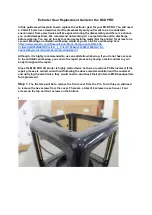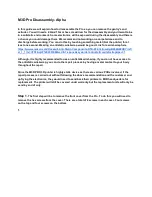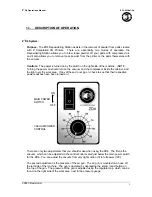
Page 1 of 3
USB Connection
The USB connection requires a standard A/B USB cable. The "A" end of the cable connects to the computer's USB port;
the "B" end connects to the printer's USB port.
Windows 98 or later
Connect the USB cable to the PC and follow the Add New Hardware Wizard to create the USB port. Follow the Add
Printer Wizard to install the printer driver from your printer's software CD-ROM. For more details, refer to the infoSMART
Knowledge Base at
www.xerox.com/officeprinting/infoSMART
, Document # 18215.
Macintosh (requires OS 9.0.4 or later)
A USB-connected printer will not show in the Chooser. Install the printer driver from your printer's software CD-ROM.
Use the Desktop Printer Utility (version 1.2 or later) to create a desktop USB printer. The utility is located in the
PhaserTools folder created during the software install. For more details, refer to the infoSMART Knowledge Base at
www.xerox.com/officeprinting/infoSMART
, Document # 33225.
Parallel Connection
The printer's parallel connection uses a parallel cable to connect your computer's parallel port to the printer's parallel
port. Install the printer driver from your printer's software CD-ROM. Select the appropriate LPT parallel port.
Ethernet Connection (recommended)
Network
Use an Ethernet connection with two twisted-pair (Category 5/RJ-45) cables and an Ethernet hub. Connect the computer
to the hub with one cable and connect the printer to the hub with the second cable. Use any port on the hub except the
uplink port. TCP/IP and EtherTalk are the most common protocols used with Ethernet cables. To print using TCP/IP, each
computer and the printer requires a unique IP address. See Setting IP Addresses.
Standalone Use
Use a crossover cable to connect the printer directly to the computer via the Ethernet port.
Setting an IP address
If your computer is on a large network, contact your network administrator for the appropriate TCP/IP addresses and
additional configurations.
If you are creating your own small Local Area Network, or connecting the printer directly to your computer over Ethernet,
use this basic procedure. The printer and computer(s) should have unique IP addresses. It is important that the
addresses are similar, but not the same. For example, your printer can have the address 192.168.1.2 while your
computer has the address 192.168.1.3. Another device can have the address 192.168.1.4, and so on.
For more details, refer to the infoSMART Knowledge Base at
www.xerox.com/officeprinting/infoSMART
,
Document # 18545.
PHASER
TM
4400 LASER PRINTER
Connection Setup
Содержание 4400B - Phaser B/W Laser Printer
Страница 1: ...P h a s e r L a s e r P r i n t e r 4400 Setup Guide ...
Страница 4: ...Phaser 4400 Laser Printer Copyright 2002 Xerox Corporation All Rights Reserved 1 550 Sheet Feeder ...
Страница 5: ...550 Sheet Feeder Phaser 4400 Laser Printer 2 ...
Страница 6: ...500 Sheet Stacker Phaser 4400 Laser Printer 3 500 Sheet Stacker ...
Страница 7: ...500 Sheet Stacker Phaser 4400 Laser Printer 4 ...
Страница 8: ...Envelope Feeder Phaser 4400 Laser Printer 5 Envelope Feeder ...
Страница 9: ...Envelope Feeder Phaser 4400 Laser Printer 6 ...
Страница 10: ...Duplex Unit Phaser 4400 Laser Printer 7 Duplex Unit ...
Страница 11: ...Duplex Unit Phaser 4400 Laser Printer 8 ...
Страница 13: ...Internal Hard Drive Phaser 4400 Laser Printer 10 ...
Страница 14: ...4400B to 4400N Upgrade Phaser 4400 Laser Printer 11 4400B to 4400N Upgrade ...
Страница 15: ...4400B to 4400N Upgrade Phaser 4400 Laser Printer 12 ...
Страница 16: ...Phaser 4400 Laser Printer Copyright 2002 Xerox Corporation All Rights Reserved 13 Adding Memory ...
Страница 17: ...Adding Memory Phaser 4400 Laser Printer 14 ...
Страница 18: ...Adding Flash DIMM Phaser 4400 Laser Printer 15 Adding Flash DIMM ...
Страница 19: ...Adding Flash DIMM Phaser 4400 Laser Printer 16 ...




































